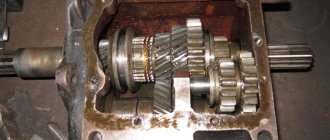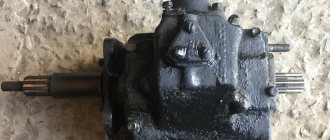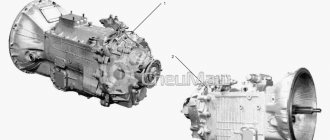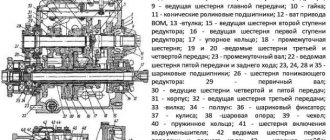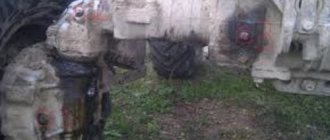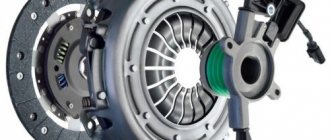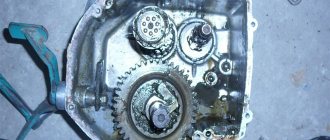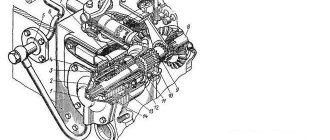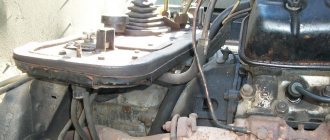Every car owner knows that the choice of transmission is a key factor that affects the dynamic performance of the car. Developers are constantly trying to improve gearboxes, but most car enthusiasts still prefer manual transmission, because, due to the prevailing stereotype, they believe that it is more reliable and easier to use. However, the reason lies elsewhere - most people are simply not familiar with the principle of operation of the machine, and therefore they are afraid of it.
In today's article we will try to describe the operating principle of an automatic transmission in as detailed and accessible a manner as possible.
What is better - manual or automatic?
As many may have already noticed, most Russian motorists prefer manual transmission. Some experts believe that this is due to the mentality of the nation, others – with established negative stereotypes.
It's a different matter for Americans, 95% of whom cannot imagine driving a car without an automatic transmission. But this is not at all surprising, because the automatic transmission was invented by American engineers who wanted to simplify the lives of drivers.
The situation is the same in Europe. If 15-20 years ago everyone used mechanics, now it has almost been squeezed out of the market.
In Russia, there is also an increase in the popularity of automatic transmissions, but, according to experts and analysts, Russians do not know how to use an automatic transmission correctly. Every day, a lot of car enthusiasts come to auto repair shops with malfunctions, the main cause of which is precisely improper operation.
Features of operation
The car will begin to move smoothly after the driver inserts the key, turns it, presses the brake, puts the selector handle in the correct position and releases the pedal.
There is no need to switch mode “D” at a traffic light. The brake pedal is being used. When parking, turn on the “P” mode.
It is possible to avoid premature breakdowns if you do not drive off-road or on uneven surfaces. It is also worth doing your best to avoid slipping. Before starting to drive a car with an automatic transmission, the driver needs to further study the documentation. Perhaps for this type of box slipping is not allowed at all. You need to know them to prevent breakdowns.
The automatic transmission structure and operating principle are folded in such a way that it is not recommended to allow severe overload. “Automatic” has sensitive mechanics, which are not designed for heavy loads. You should not put large loads in the cabin or even pull a trailer behind you.
Thus, it becomes clear that cars with automatic transmission are conquering the market. More than 80% of the European population already drive an automatic car.
How does automatic transmission work?
In order to make the operating principle of an automatic transmission more clear, we will conditionally divide it into three parts: mechanical, electronic and hydraulic.
Let's start the discussion, of course, with the mechanical one, since it is this element that changes gears.
The hydraulic part is a kind of intermediary, which is a connecting link.
And finally, electronic, which is considered the brain of the transmission, responsible for switching modes, as well as feedback.
Everyone understands that the heart of a car is the engine. The transmission does not pretend to play this role at all, because it can safely be called the brain of the car. The main goal of an automatic transmission is to transform the engine power into a force that creates conditions for vehicle movement. An important role in this process is played by the torque converter and planetary gears.
Planetary series
The torque converter can increase torque, but only up to a certain limit. The automatic transmission design for a more significant increase in torque, for example, when overcoming inclines, as well as for reversing, uses planetary gears. The planetary gear also ensures smooth gear shifting when driving without loss of engine power. Thanks to it, switching occurs without the shocks that occur during operation of a conventional transmission.
The planetary set includes the following elements:
- sun gear;
- satellites;
- epicycle;
- drove.
They are called a planetary gear due to the fact that friction wheels, rotating simultaneously around their axes and moving with these axes, are very reminiscent of the planets of the solar system. Their relative position determines which gear is currently engaged.
Torque converter
By analogy with a manual transmission, the torque converter performs clutch functions and also regulates the gearbox, taking into account the engine speed and power output.
The design of the torque converter consists of three parts:
- Centripetal turbine;
- Centrifugal pump;
- Guide apparatus-reactor;
Due to the fact that the turbine and pump are as close to each other as possible, the working fluids are in constant motion. Thanks to this, it is possible to achieve minimal energy losses. In addition, the torque converter boasts very compact dimensions.
It is worth noting that the crankshaft is directly connected to the pump wheel, and the box shaft is directly connected to the turbine. It is due to this that the torque converter does not have a rigid connection between the driving and driven elements. Working fluids transfer energy from the engine to the transmission, which, in turn, transfers it through the pump blades to the turbine blades.
Conclusion
What conclusion can be drawn? Engineers have created an automatic transmission that is complex enough to simplify its operation as much as possible. As a result, the convenience and functionality of a modern automatic transmission outweighs any doubts about its reliability. It is for these qualities that drivers appreciate the opportunity to use an automatic transmission and not create unnecessary problems for themselves in life. Yes, an automatic transmission can fail, like any other component of a car, but with proper use it can last a very long time.
Fluid coupling
If we talk about the fluid coupling, its operating principle is very similar - it also transmits CM without affecting its intensity.
The torque converter is equipped with a reactor primarily to change the CM. In essence, this is the same wheel with blades, except that it is planted more rigidly and less maneuverable. It returns oil from the turbine to the pump. Some features have reactor blades, the channels of which gradually narrow. Due to this, the speed of movement of working fluids increases significantly.
What does an automatic transmission consist of?
The torque converter interacts with the clutch and is not in contact with the driver.
Planetary gear - interacts with the gears in the box, and when changing gears, changes the configuration of the transmission.
The brake band, rear and front clutches directly change gears.
The control device is a unit that consists of a pump, valve box and oil sump.
The valve body is a system of valve channels that monitor and control the engine load.
Torque converter - designed to transmit torque from the power unit to the elements of the automatic transmission. It is located between the gearbox and the motor, and thus serves as a clutch. It is filled with working fluid, which captures and transmits engine forces to the oil pump, located directly in the box.
As for the oil pump, it already transfers the working fluid to the torque converter, thus creating the most optimal pressure in the system. Therefore, the myth that a car with an automatic transmission can be started without a starter is a complete lie.
The gear pump receives energy directly from the engine, from which we can conclude that when the engine is turned off, there is completely no pressure in the system, even if the automatic transmission shift lever is not in its initial state. Therefore, forced rotation of the propeller shaft will not be able to start the engine.
Planetary gear set is often used in automatic transmissions, as it is considered more modern and technologically advanced than the parallel shaft used in mechanics.
Parts of the clutch - the piston is forced to move by excessive oil pressure. The piston itself presses the driving elements very tightly against the driven ones, forcing them to rotate as a single unit and transmit the CM to the bushing. It is worth noting that the automatic transmission contains several such planetary mechanisms.
Friction discs transfer fluid directly to the wheels of the car.
Brake band - used to block the elements of the planetary mechanism.
The valve body is one of the most complex mechanisms in an automatic transmission, which is called the “brains of the transmission.” It is worth noting that repairing this element is very expensive.
History of appearance
The first development that can be classified as an automatic transmission appeared in 1908 at the Ford plant in America. Model T was equipped with a planetary, still manual, gearbox. This device was not automatic, and required drivers to have a certain set of skills and actions to control, but it was much easier to use than manual transmissions without synchronization that were common at that time. The second important stage in the emergence of modern automatic transmissions was the transfer of clutch control from the driver to a servo drive in the 30s of the 20th century by General Motors. Such automatic transmissions were called semi-automatic. The first truly automatic planetary gearbox, Kotal, was installed in Europe in 1930. At this time, various companies in Europe were developing clutch and brake band systems.
Drawing of the Kotal checkpoint
The first automatic transmissions were very expensive and unreliable, until at the end of the 30s experiments began to introduce hydraulic elements into their design to replace servos and electromechanical controls. This development path was followed by Chrysler, which developed the first torque converter and fluid coupling. Modern automatic transmission designs were invented in the 40–50s of the 20th century by American designers. In the 80s of the 20th century, automatic transmissions began to be equipped with computer control; for fuel economy, 4- and 5-speed automatic transmissions appeared.
Types of automatic transmission
The permanent race for technical equipment of cars forces developers to come up with more and more sophisticated technologies and designs in order to overtake competitors. It is worth noting that this has a positive effect on the development of the vehicle chassis. One of the most important discoveries was the invention of the automatic transmission. It immediately began to be in incredibly high demand, as it significantly simplifies the management process. In addition, it is very easy to use and reliable. Analysts claim that in the near future it will completely displace manual transmissions from the market.
Today, automatic transmissions are used in both cars and trucks, regardless of the type of drive.
It is known that when driving a car with a manual transmission, you have to constantly keep your hand on the gear shift, which significantly reduces concentration on the road. The automatic transmission is practically devoid of such shortcomings.
The main advantages of the automatic transmission:
- Management efficiency increases;
- Smoother transition between gears even at high speeds;
- The engine is not overloaded;
- Gears can be changed either manually or automatically;
Modern automatic transmissions, from the point of view of the monitoring and control system, can be divided into two types:
- Transmission with hydraulic device;
- Transmission with an electronic device, or the so-called robotic gearbox;
This should become clearer after reading the example below:
“Imagine a situation where a car is moving on a flat road and gradually approaches a steep hill. If you simply observe this situation from the side for some time, you will notice that after increasing the load, the machine begins to lose speed, and, consequently, the intensity of rotation of the turbine also decreases. This leads to the fact that the working fluid begins to resist movement. In this case, the circulation rate increases sharply, which helps to increase the CM to the point at which equilibrium occurs in the system.”
The same operating principle applies when the car starts moving. The only difference is that in this case the accelerator is also used. Thanks to it, the intensity of the crankshaft and pump wheel revolutions increases, while the turbine remains stationary, which allows the engine to idle. It is worth noting that the KM increases sharply, and upon reaching a certain point, the torque converter begins to serve as a link that connects the driven and driving elements together. It is all these points that allow you to significantly reduce the level of fuel consumption while driving, and more effectively perform engine braking if necessary.
So why then connect the automatic transmission to the torque converter if it is independently capable of changing the intensity of the torque converter?
Here's why: the torque change factor using a torque converter usually does not exceed 2-3.5. This is not enough for the automatic transmission to work properly.
Unlike a manual transmission, an automatic transmission changes gears using friction clutches and band brakes. The system automatically determines the desired speed taking into account the speed of movement and the force on the accelerator pedal.
In addition to the planetary mechanism and torque converter, the automatic transmission also includes a pump that lubricates the box. The oil is cooled by a cooling radiator.
Features and Features
Automatic transmission allows you to better control the car, reducing the requirements for driver action - controlling the clutch and shift knob makes driving less tiring. The automatic transmission has a neutral position, a parking position (the rotation of the box is additionally blocked using units), reverse gear and several speeds for driving. Switching is carried out based on speed and conditions (for example, when driving on a hill, a lower speed may be automatically switched on). The shift time of a working gearbox for city cars is around 150 ms, which is much faster than the reaction of an ordinary driver. The main control element of the automatic transmission is the gear shift knob; it can be located near the steering wheel (old American and Japanese sedans or modern minivans) or at the traditional location of the automatic transmission lever. On older luxury models, the box could be controlled using a button panel. To avoid accidental switching or dangerous situations, automatic transmissions use various types of protection. In cars with automatic transmission, the engine cannot be started if the selector lever is in the speed position. Switching modes is carried out using a button for floor-mounted lever layouts, or by pulling the lever when located on the steering wheel. The car can only be removed from parking with the brake pressed. In some cases, the slot is made in the form of steps.
Automatic transmission selector
Common automatic transmission modes: P – parking, the automatic transmission is mechanically locked; when driving on horizontal surfaces, using the parking brake is not necessary. N – neutral. You can tow the car. L(D1, D2, S) – driving in a lower gear (1st gear or 2nd gear). D – automatic switching mode from first to last speed. R – reverse mode. In addition, the automatic transmission may have an overdrive button, which prohibits changing to a higher gear when overtaking. Neutral is usually located between D and R, or R is at the opposite end of the selector lever. This requirement was introduced to avoid accidents on the road and parking.
Also, automatic transmissions may have different operating modes and protocols. Eco is an economical mode, implemented differently for different companies. *Snow(Winter) – starting from a stop in second or third gear for slippery road surfaces or moving in a snowdrift or mud. *Sport(Power) – gears shift at higher engine speeds. *ShiftLock (button or key) – unlocking the selector when the engine is off, used to transport the car if the engine or battery is faulty. Some automatic transmissions have a manual gear shift mode. The most successful and widespread version of such an automatic transmission was Tiptronic, created by Porsche. A distinctive feature is the control, it is made in the form of the letter H and has the symbols “+” and “–“.
Tiptronic Porsche Cayenne
In addition to Tiptronic, automatic transmissions include a CVT and a robotic gearbox.
The difference between the automatic transmission of rear-wheel drive and front-wheel drive vehicles
There are a number of differences between the automatic transmission layout of front- and rear-wheel drive vehicles. The automatic transmission of front-wheel drive cars is more compact and has a separate compartment called the differential.
In all other aspects, both transmissions are identical, both structurally and functionally.
To effectively perform all functions, the automatic transmission has the following elements: a torque converter, a control unit and a mechanism for selecting the driving mode.
We hope that our article was as useful as possible for you and helped you understand the principles of automatic transmission operation.
Panel symbols
An automatic transmission whose operating principle is very simple, has a panel with alphabetic symbols and numbers. To control the automatic transmission, it is worth understanding them. Designations may vary depending on the make of the machine.
R - parking. Turns on when the car is parked. This is a kind of parking brake in which there is a shaft lock.
R - reverse speed. It turns on when the car starts moving backwards.
N - popularly called “neutral”. If the car is at neutral speed, then its wheels are not locked. If something happens, the car may “roll”.
D - stands for forward movement.
A - automatic mode.
M - imitation of a manual transmission in a simplified mode.
L and B - low gear.
S - sport mode.
W - “winter” mode, allowing you to start from 2nd gear.
OD - accelerated mode.
E - economical mode.
Before you learn how an automatic transmission works, as well as what certain symbols on the panel mean, you need to read the instruction manual. For different car models, the meaning of the letters may differ. For example, sometimes B means lock, and L is translated as “Lock,” which means “lock.”
